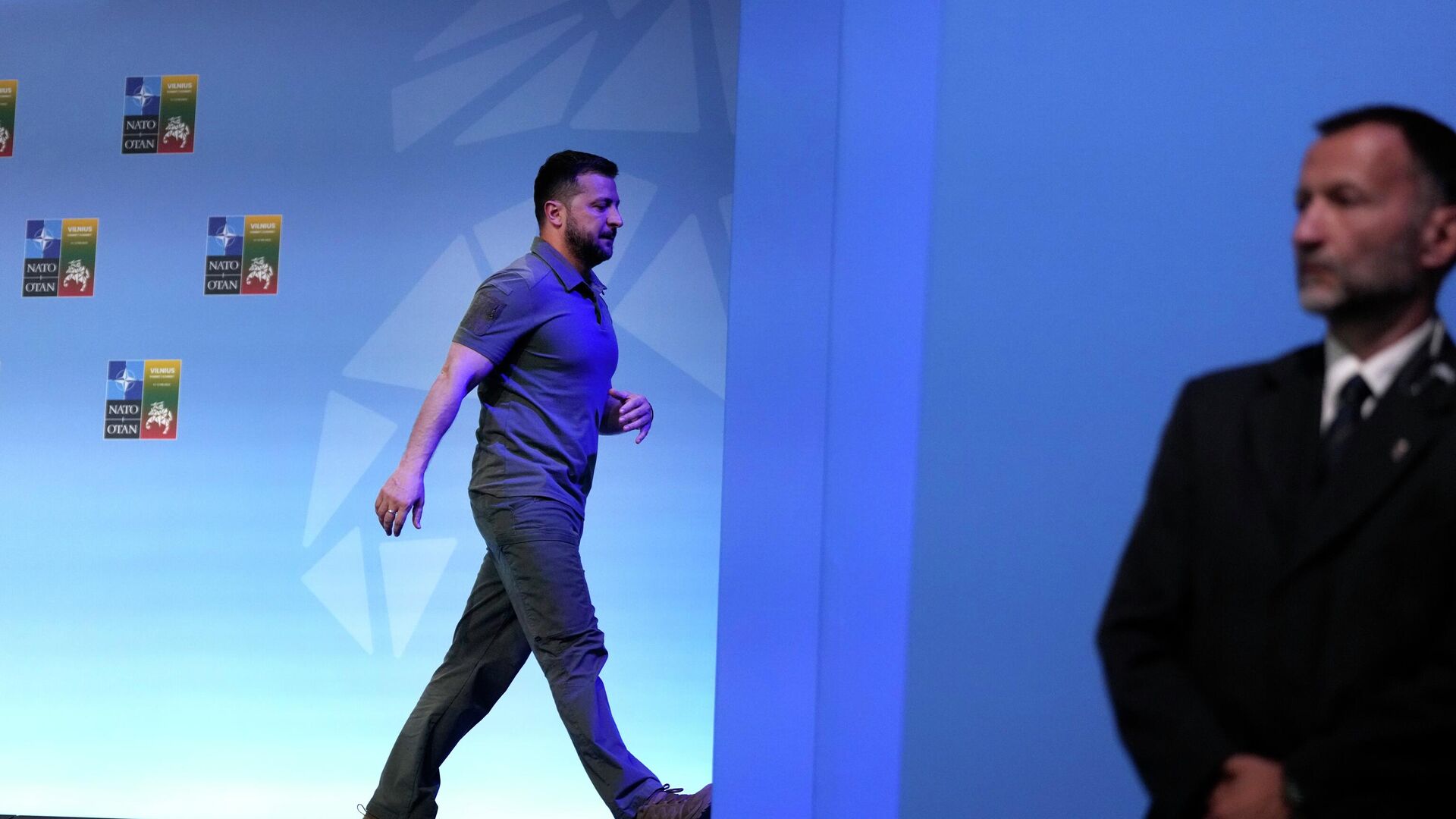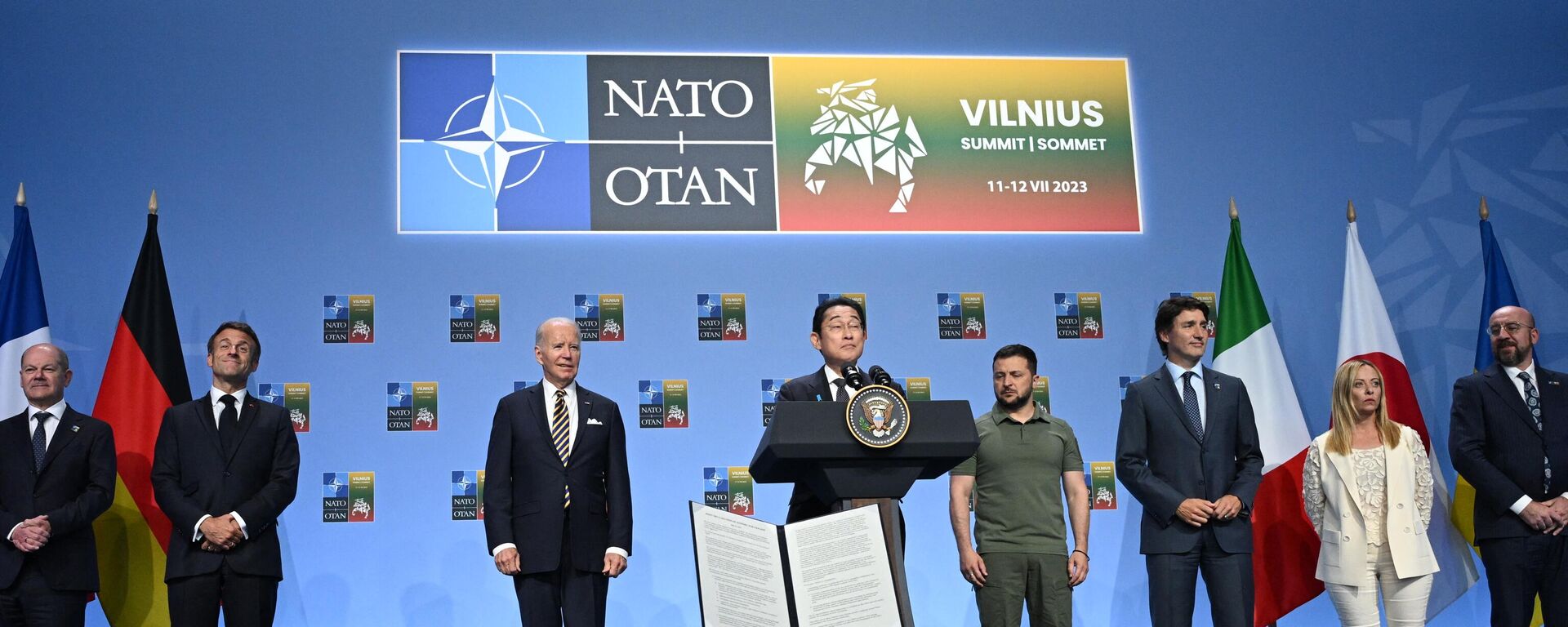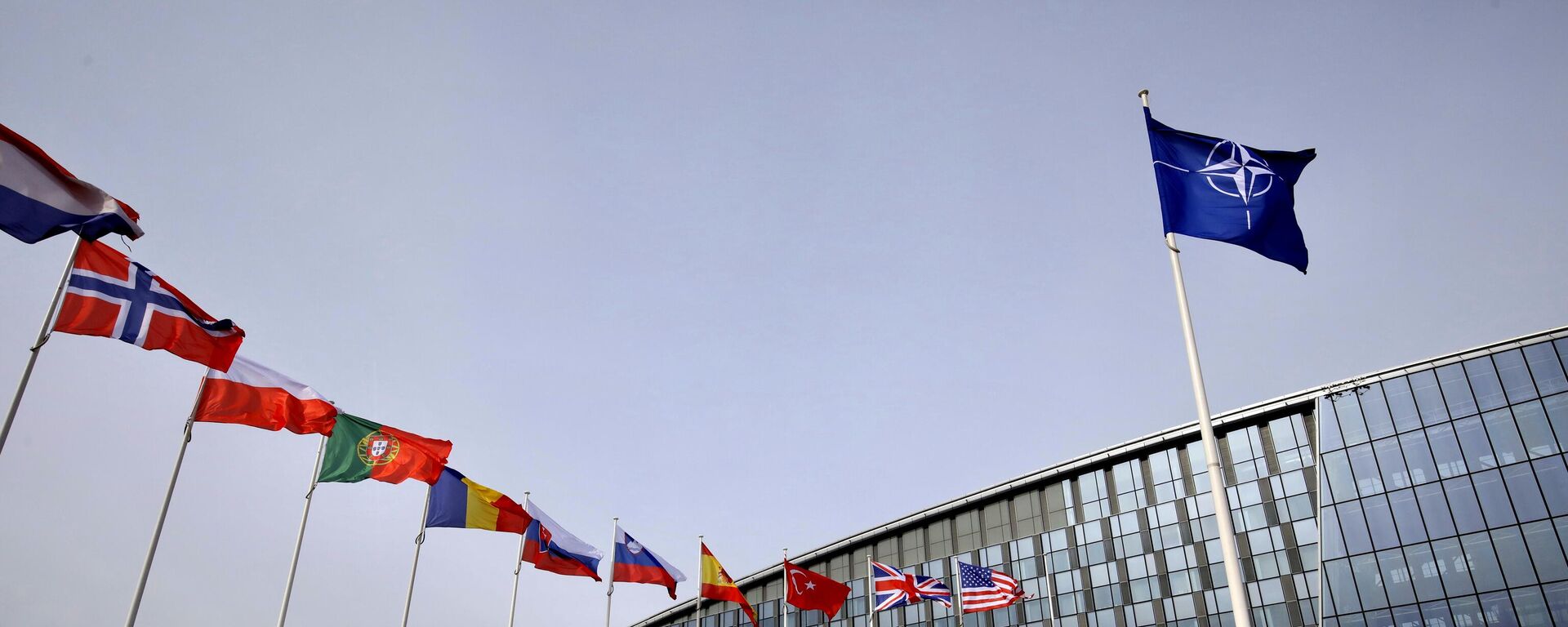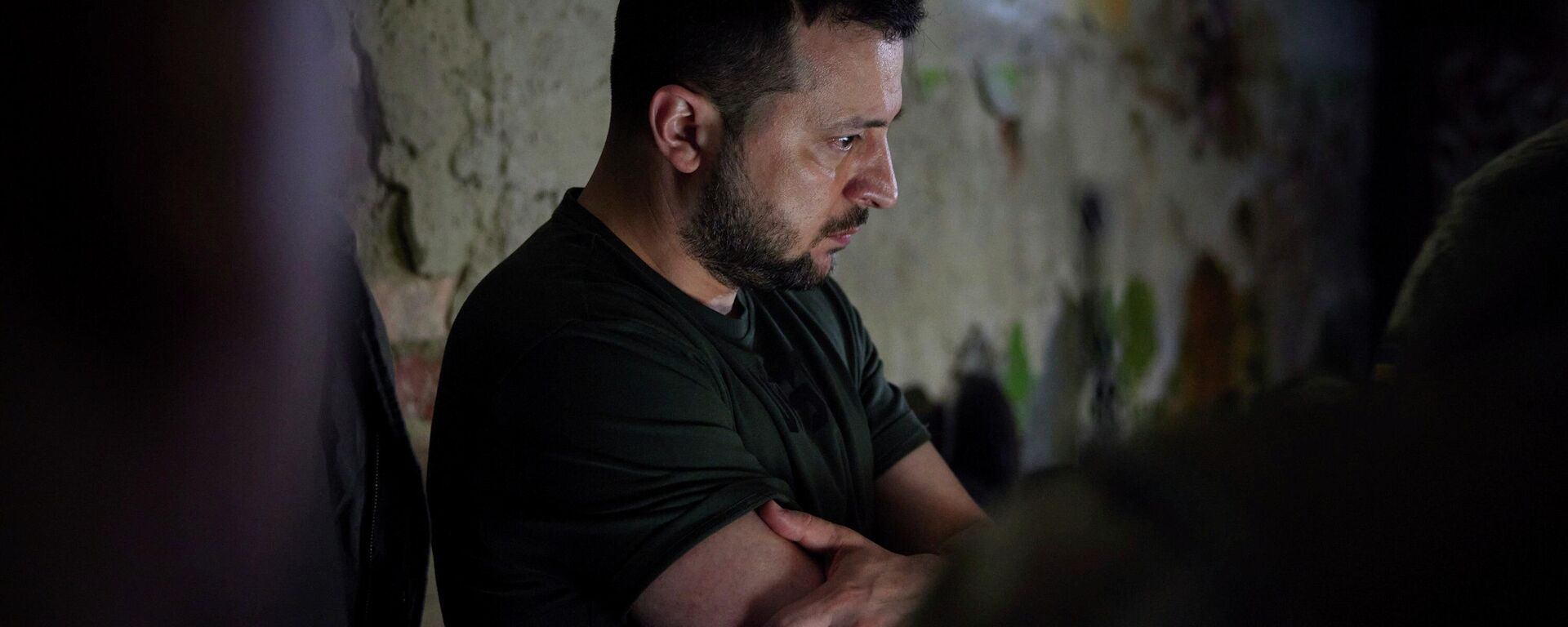https://sputnikglobe.com/20230713/scott-ritter-nato-summit-serves-up-cringe-nothing-burger--1111854432.html
Scott Ritter: NATO Summit Serves Up Cringe Nothing-Burger
Scott Ritter: NATO Summit Serves Up Cringe Nothing-Burger
Sputnik International
Back in 1984, Wendy’s (an American fast-food chain) released an advertisement starring an elderly actress named Clara Peller. The premise of the ad had Peller ordering a hamburger from an unnamed competitor, only to receive a very large bun containing a very small beef patty on the inside.
2023-07-13T15:31+0000
2023-07-13T15:31+0000
2023-07-13T15:43+0000
nato
ukraine
russia
analysis
nato summit in vilnius
russia-nato showdown
https://cdn1.img.sputnikglobe.com/img/07e7/07/0d/1111855778_0:0:3072:1728_1920x0_80_0_0_d6d22d43f42735bc7ce20f56ccd9f660.jpg
Upon examining the burger, Peller looks up in exasperation, and proclaims “Where’s the beef?”In the aftermath of the Vilnius-hosted NATO Summit, a two-day affair spanning July 11-12, one cannot help but feel that the spirit of Clara Peller was channeled into the President of Ukraine, Volodymyr Zelensky, as he pored over the results of the event, and contrasted them with the expectations that existed going into the summit. I don’t know how to say “Where’s the beef” in Ukrainian, but something like that phrase had to be coursing through the mind of the Ukrainian President as he examined the big “nothing burger” that NATO had delivered up for him.The Vilnius Summit was intended to showcase the alliance’s unity and resolve in the face of the challenges presented by Russia and the ongoing conflict in Ukraine. There had been a great deal of discussion prior to the summit about the prospects of Ukrainian membership in NATO. It was understood by all parties that, while the conflict between Ukraine and Russia remained in an active phase, Ukrainian membership was impossible, if for no other reason that, under Article 5 of the NATO charter, NATO would immediately find itself in a war with Russia which had a good chance of going nuclear.The working premise going into the Vilnius Summit was that NATO would empower Ukraine to carry out a massive counteroffensive designed to break through the Russian defenses and drive to the Sea of Azov, thereby severing the land bridge between Crimea and Russia, forcing Russia to negotiate an end to the conflict. At that juncture, having “frozen” the conflict on terms that would be unfavorable to Russia, NATO would extend an invitation to Ukraine for membership, thereby shrouding Ukraine’s gains with Article 5 protections while effectively checking any future Russian offensive operations.In the weeks leading up to the summit, Ukraine was desperately trying to do its part, throwing its newly constituted NATO-trained and equipped assault brigades at prepared Russian defenses in actions which made the infamous “Charge of the Light Brigade” seem like the epitome of military planning and execution by comparison. With much of its NATO-provided weaponry, including the much-touted Leopard tanks and Bradley infantry fighting vehicles, destroyed or damaged without ever reaching the main Russian defensive positions, and some 20,000 Ukrainian casualties, the Ukrainian counteroffensive fizzled out. Instead of presenting his NATO partners with a decisive Ukrainian victory, Zelensky confronted his erstwhile allies with the harsh reality that not only would the conflict with Russia not be ending any time soon, but also the growing realization that, when it did end, it would be as a decisive Russian military victory.Confronted with this reality, NATO sought to soften expectations about Ukrainian membership. Rather than provide Ukraine with a concrete road map to membership, NATO declared that it would extend an invitation to Ukraine when “conditions are met”, one of which is that the conflict with Russia must be over. NATO offered up as a consolation prize the establishment of a NATO-Ukraine Council “to advance political dialogue, engagement, cooperation, and Ukraine’s Euro-Atlantic aspirations for membership in NATO,” and promised to “continue our support for as long as it takes.”For Zelensky, these words ring hollow in the face of a deteriorating situation on a battlefield largely defined by the previous support of NATO. And the harsh reality of the battlefield looms large as Zelensky departs Vilnius with little more than assurances that NATO will continue to support Ukraine along the lines of what it has done to date. But all that this support has done is condemn hundreds of thousands of Ukrainian soldiers to death, while stripping bare both the armories and coffers of Ukraine’s NATO partners.Zelensky must likewise reflect on the words of President Joe Biden who, in an interview with CNN, noted that Ukraine was “not ready for membership in NATO,” adding that any such dialogue was “premature” while Ukraine was in the middle of a conflict. Biden also stated that he did not “think there is unanimity in NATO about whether or not to bring Ukraine into the NATO family now, and that the process could take place only after a peace agreement with Russia was in place.”But to achieve a peace that created the conditions favorable to Ukraine joining NATO meant that Ukraine must first defeat the Russian army on the field of battle. To do that, Ukraine would need NATO to radically alter the formulation upon which current levels of military assistance were being calculated, if for no other reason that the current formulations were, simply put, not working. But NATO is neither inclined nor capable of changing this formulation. Its goal has never been to defend Ukraine, but rather defeat Russia, a cause it is willing to pursue to the last Ukrainian.Zelensky came to Vilnius like customers flock to fast food restaurants, full of expectations about the delicious burger they are going to order and consume, only to find himself cast in the role of Clara Peller, shouting out in exasperation, “Where’s the beef?”It's not the role Zelensky wanted or expected rolling into the Vilnius Summit. For more than 500 days he had been cast as the modern-day incarnation of Winston Churchill, a heroic figure standing firm against the forces of evil. But Zelensky operates in the theater of the absurd, where perception trumps reality until which time reality hits hard, and the script changes. The narrative has flipped, with Ukraine transformed from the leading character into part of the supporting cast. Zelensky the politician must be disappointed by this turn of events. But Zelensky the actor simply looks down at the words put before him, written by others, takes his cue, and reads aloud.“Where’s The Beef?”The answer doesn’t matter. There is no beef. It’s just a script. And Zelensky is just an actor, playing out his role in the tragic opera that has become the Russian-Ukrainian conflict, watching helplessly as his nation and people are being sacrificed on behalf of a dysfunctional NATO alliance that proclaims its mission as peace, but whose only product is war.
https://sputnikglobe.com/20230712/nato-summit-exposes-fractures-in-alliance-over-support-for-ukraine-1111839544.html
https://sputnikglobe.com/20230712/russian-foreign-ministry-vilnius-summit-shows-nato-back-to-cold-war-era-behavior-1111840578.html
https://sputnikglobe.com/20230520/bloody-jester-volodymyr-zelenskys-rise-to-power-1110465049.html
ukraine
russia
Sputnik International
feedback@sputniknews.com
+74956456601
MIA „Rossiya Segodnya“
2023
Scott Ritter
https://cdn1.img.sputnikglobe.com/img/07e6/0c/17/1105733958_0:0:334:334_100x100_80_0_0_b457e4e9c850ef224b0cc79059bb38df.jpg
Scott Ritter
https://cdn1.img.sputnikglobe.com/img/07e6/0c/17/1105733958_0:0:334:334_100x100_80_0_0_b457e4e9c850ef224b0cc79059bb38df.jpg
News
en_EN
Sputnik International
feedback@sputniknews.com
+74956456601
MIA „Rossiya Segodnya“
Sputnik International
feedback@sputniknews.com
+74956456601
MIA „Rossiya Segodnya“
Scott Ritter
https://cdn1.img.sputnikglobe.com/img/07e6/0c/17/1105733958_0:0:334:334_100x100_80_0_0_b457e4e9c850ef224b0cc79059bb38df.jpg
nato summit, russia-nato showdown, nato summit in vilnius, nato expansion, nato enlargement
nato summit, russia-nato showdown, nato summit in vilnius, nato expansion, nato enlargement
Scott Ritter: NATO Summit Serves Up Cringe Nothing-Burger
15:31 GMT 13.07.2023 (Updated: 15:43 GMT 13.07.2023) Back in 1984, Wendy’s (an American fast-food chain) released an advertisement starring an elderly actress named Clara Peller. The premise of the ad had Peller ordering a hamburger from an unnamed competitor, only to receive a very large bun containing a very small beef patty on the inside.
Upon examining the burger, Peller looks up in exasperation, and proclaims “Where’s the beef?”
In the aftermath of the
Vilnius-hosted NATO Summit, a two-day affair spanning July 11-12, one cannot help but feel that the spirit of Clara Peller was channeled into the President of Ukraine, Volodymyr Zelensky, as he pored over the results of the event, and contrasted them with the expectations that existed going into the summit. I don’t know how to say “Where’s the beef” in Ukrainian, but something like that phrase had to be coursing through the mind of the Ukrainian President as he examined the big “nothing burger” that NATO had delivered up for him.
The Vilnius Summit was intended to showcase the alliance’s unity and resolve in the face of the challenges presented by Russia and the ongoing conflict in Ukraine. There had been a great deal of discussion prior to the summit about the prospects of Ukrainian membership in NATO. It was understood by all parties that, while the conflict between Ukraine and Russia remained in an active phase,
Ukrainian membership was impossible, if for no other reason that, under Article 5 of the NATO charter, NATO would immediately find itself in a war with Russia which had a good chance of going nuclear.
The working premise going into the Vilnius Summit was that
NATO would empower Ukraine to carry out a massive counteroffensive designed to break through the Russian defenses and drive to the Sea of Azov, thereby severing the land bridge between Crimea and Russia, forcing Russia to negotiate an end to the conflict. At that juncture, having “frozen” the conflict on terms that would be unfavorable to Russia, NATO would extend an invitation to Ukraine for membership, thereby shrouding Ukraine’s gains with Article 5 protections while effectively checking any future Russian offensive operations.
In the weeks leading up to the summit, Ukraine was desperately trying to do its part, throwing its newly constituted NATO-trained and equipped assault brigades at prepared Russian defenses in actions which made the infamous “Charge of the Light Brigade” seem like the epitome of military planning and execution by comparison. With much of its NATO-provided weaponry, including the much-touted Leopard tanks and Bradley infantry fighting vehicles, destroyed or damaged without ever reaching the main Russian defensive positions, and some 20,000 Ukrainian casualties, the Ukrainian counteroffensive fizzled out. Instead of presenting his NATO partners with a decisive Ukrainian victory, Zelensky confronted his erstwhile allies with the harsh reality that not only would the conflict with Russia not be ending any time soon, but also the growing realization that, when it did end, it would be as a decisive Russian military victory.
Confronted with this reality, NATO sought to soften expectations about Ukrainian membership. Rather than provide Ukraine with a concrete road map to membership, NATO declared that it would extend an invitation to Ukraine when “conditions are met”, one of which is that the conflict with Russia must be over. NATO offered up as a consolation prize the establishment of a NATO-Ukraine Council “to advance political dialogue, engagement, cooperation, and Ukraine’s Euro-Atlantic aspirations for membership in NATO,” and promised to “continue our support for as long as it takes.”
For Zelensky, these words ring hollow in the face of a deteriorating situation on a battlefield largely defined by the previous support of NATO. And the harsh reality of the battlefield looms large as Zelensky departs Vilnius with little more than assurances that NATO will continue to support Ukraine along the lines of what it has done to date. But all that this support has done is condemn hundreds of thousands of Ukrainian soldiers to death, while stripping bare both the armories and coffers of Ukraine’s NATO partners.
Zelensky must likewise reflect on the words of President Joe Biden who, in an interview with CNN, noted that Ukraine was “not ready for membership in NATO,” adding that any such dialogue was “premature” while Ukraine was in the middle of a conflict. Biden also stated that he did not “think there is unanimity in NATO about whether or not to bring Ukraine into the NATO family now, and that the process could take place only after a peace agreement with Russia was in place.”
But to achieve a peace that created the conditions favorable to Ukraine joining NATO meant that Ukraine must first defeat the Russian army on the field of battle. To do that, Ukraine would need NATO to radically alter the formulation upon which current levels of military assistance were being calculated, if for no other reason that the current formulations were, simply put, not working. But NATO is neither inclined nor capable of changing this formulation. Its goal has never been to defend Ukraine, but rather defeat Russia, a cause it is willing to pursue to the last Ukrainian.
Zelensky came to Vilnius like customers flock to fast food restaurants, full of expectations about the delicious burger they are going to order and consume, only to find himself cast in the role of Clara Peller, shouting out in exasperation, “Where’s the beef?”
It's not the role Zelensky wanted or expected rolling into the Vilnius Summit. For more than 500 days he had been cast as the modern-day incarnation of Winston Churchill, a heroic figure standing firm against the forces of evil. But
Zelensky operates in the theater of the absurd, where perception trumps reality until which time reality hits hard, and the script changes. The narrative has flipped, with Ukraine transformed from the leading character into part of the supporting cast. Zelensky the politician must be disappointed by this turn of events. But Zelensky the actor simply looks down at the words put before him, written by others, takes his cue, and reads aloud.
The answer doesn’t matter. There is no beef. It’s just a script. And Zelensky is just an actor,
playing out his role in the tragic opera that has become the Russian-Ukrainian conflict, watching helplessly as his nation and people are being sacrificed on behalf of a dysfunctional NATO alliance that proclaims its mission as peace, but whose only product is war.






